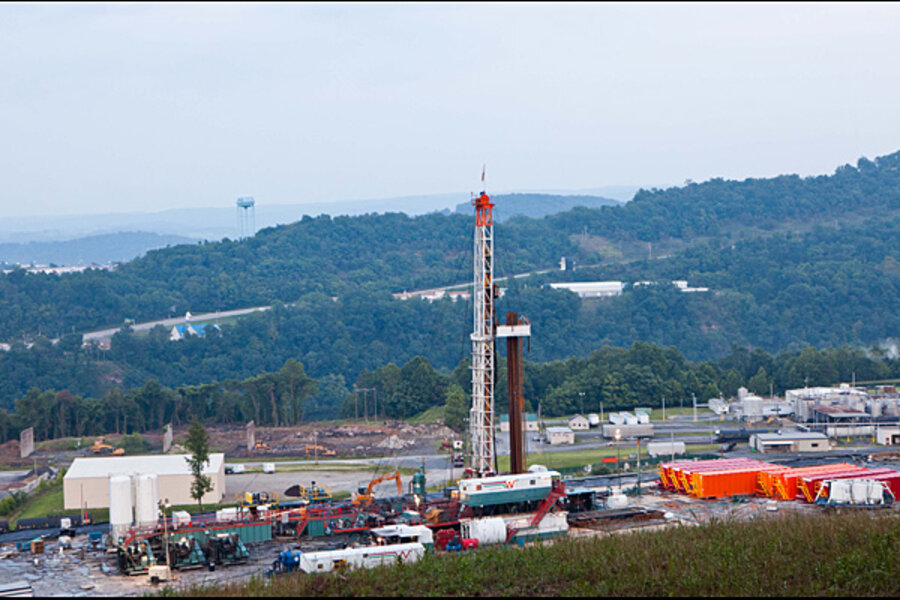Fracking the US trade deficit
Loading...
The US is slowly chipping away at its trade deficit, which should create more jobs, more economic growth, less unemployment, and a smaller federal deficit.
And the boom in domestic energy production is a key factor behind that narrowing trade deficit
Over the past decade, oil and gas production has surged at vast shale formations in Texas, North Dakota, Pennsylvania, and elsewhere across the US. That has led to a rise in exports of petroleum products and a reduction in the amount of oil and gas the US imports from abroad.
It's one benefit of the domestic hydraulic fracturing and horizontal drilling revolution that has stirred passion on all sides of the debate over America's energy future. The costs are damage to local environments, critics say, and a continued reliance on a fuel that – albeit cleaner than coal – still emits significant quantities of heat-trapping gases into the atmosphere. Those are economic costs that don't necessarily show up in the short term, critics say, but are apparent in a changing climate's threat to resources and infrastructure.
If the boom continues, analysts believe it will continue to bolster the US economic outlook at home, as well as its geopolitical stance abroad.
“For the first time in 40 years, the US could have an effective strategy for creating a normal, open market for oil and gas and energy that would mirror the open markets we have in currencies, manufactured goods, and most other things,” Amy Myers Jaffe, executive director for energy and sustainability at University of California, Davis, says in a telephone interview. “Over time, hopefully, that would mean the giant number of people that do not have access to modern fuel would have access.”
The US trade deficit dropped 3.5 percent from $559.9 billion in 2011 to $540.4 billion in 2012. A 10.7 percent reduction in the petroleum trade deficit helped offset an 8.8 percent increase in the trade deficit of nonpetroleum goods. Improved efficiency measures are also helping to drive down demand for foreign fuels.
In June, the US trade deficit dropped to $34.2 billion, the smallest it's been since October 2009. It expanded slightly in July and is expected to have expanded again in August, but Tuesday's numbers were not available from the Department of Commerce because of the ongoing government shutdown.
Despite the slight rebound, domestic oil and gas production is expected to continue to help balance the trade deficit, or at least keep it in check. This year, the US is expected to surpass Russia and Saudi Arabia as the world’s largest producer of oil and gas, according to data released last week by the US Energy Information Administration. In oil alone, the US is projected to become the world’s largest producer by around 2020, according to the International Energy Agency.
The cheap, domestic fuel is drawing energy-intensive manufacturing and chemical processing companies back to US shores after leaving for cheaper destinations 15 years ago, according to Pete Stark, an energy analyst for IHS.
“We’re looking at between now and 2025 probably a doubling in potential exports in the products from the chemical industry,” Mr. Stark says in a telephone interview. “Rather than exporting the energy, we’ll be exporting the value-added products–the plastics, the vinyls, polypropylene, and polyethylene.”
There's also an opportunity for the US to become a major player in the global natural gas market as the Department of Energy works through a list of applications to flip import ports into export. So far this year, the department has approved three liquefied natural gas export terminals and energy companies are clamoring for more, despite concerns that exports will increase heating and energy costs for US businesses and consumers.
"[Natural gas] is not cheap outside the US, so when we devote resources to nat gas for export the revenue we can get for that can buy a whole lot more goods from other countries," says W. David Montgomery, senior vice president of New York-based NERA Economic Consulting. "In this case, it’s not because we raise the price of something it’s because we became so much better at producing it."
It’s all contingent on oil prices remaining high, environmental risks remaining under control, and shale plays delivering on their promise. Shale production requires an intense amount of drilling sustained over a long amount of time and wells deplete more quickly than conventional oil and gas wells. By December 2012 it took about 90 new producing wells per month just to maintain the largest US shale oil play’s oil production of 770,000 barrels per day, according to a June 2013 study by Harvard University’s Belfer Center for Science and International Affairs.
Contaminated water and methane leaks have given hydraulic fracturing a sour name among much of the US public, 49 percent of which oppose increased use of the drilling technique, according to a September Pew poll. And while natural gas is cleaner-burning than coal, it’s still a fossil fuel that some say only prolongs a transition to a post-carbon economy at a time when the concentrations of carbon dioxide in the Earth’s atmosphere are hitting record highs.








